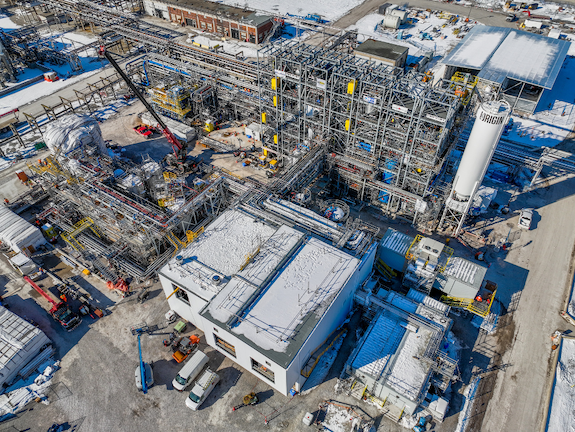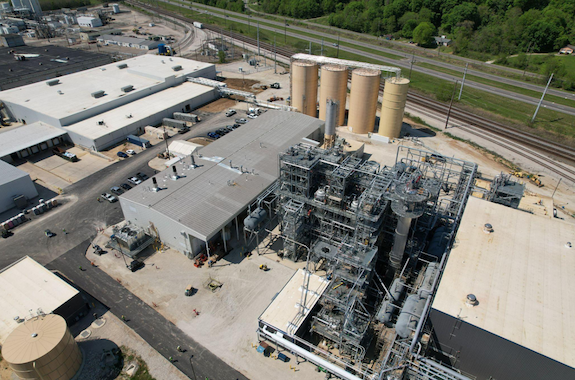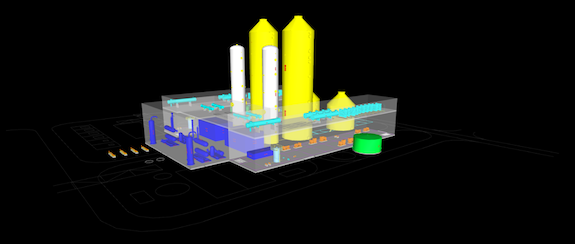Tipping the Scale on CO2 Levels: Fast-Tracking Bioeconomy Decarbonization
By Mauricio Villegas, Manager of Business Development, Koch Modular Process Systems
Special to The Digest
Carbon dioxide (CO2) levels continue to increase globally, but the degree of growth is starting to tapper off. In 2021 the IEA reported that CO2 levels increased by 6% from the prior year, partly due to the significant decline during the COVID-19 pandemic. Earlier this year, research showed that there had been a slowdown to the rate of carbon dioxide levels in 2022, whereby CO2 levels only rose by 1%. The direct impact of greenhouse gases on the planet is becoming a catalyst for change driving new international government policies to employ new technologies to reduce and limit greenhouse gas emissions and capture CO2. To make a global impact, the IEA is reporting that there needs to be a yearly 7% reduction in greenhouse gas emissions to meet emissions goals.
Decarbonization is a solution that many are pursuing that shifts away from petroleum-based feedstocks and energy sources to replace them with renewable energy. These resources include wind, solar, and biomass. Decarbonization has created an opportunity for industry innovators to capture an emerging market in the bio-economy. It is now a race to deliver technology that produces net-zero and even net-negative carbon footprint and captures market share. For example, industry sectors such as bio-derived and alternative fuels, renewable chemicals and materials, recycled plastics, renewable natural gas and biogas, and carbon capture are experiencing unprecedented growth. Other sectors, such as recycled battery materials, are on the cusp of witnessing growth as electric vehicles (EV) and other advanced batteries begin to reach the end of life.
Companies that can develop and commercialize novel technology and provide alternate pathways to finished goods by decarbonizing their manufacturing process and mitigating their potential impact on our environment; will disrupt and transform industry across every market sector.
The New Ways
When we consider the decarbonization of industrial processes, various methods exist to achieve this goal, including substituting non-petroleum feedstocks, recycling petroleum-based feedstocks, and CO2 capture. Below, we will explore three approaches applied today and the various innovators in decarbonization technologies.
Substitution of Non-Petroleum Feedstocks
Companies are looking into new technologies that enable the substitution of traditional fossil fuel-based power with low-carbon power from renewable energy sources. These sources include wind, solar, and biomass. Rather than extracting carbon from the conventional petroleum route, carbon is removed from other resources for its manufacturing process.
One company following suit is Origin Materials, whose process replaces oil with 100% renewable plant-based feedstock to manufacture PET plastic (Image 1). Their choice of biomass is sustainably harvested wood, but any cellulose can be used within their process. Their carbon-negative process eliminates the need for fossil resources. It captures carbon in the process, resulting in a positive impact on the planet.

Figure 1: Origin Materials Biomass truckable modular process system
Sustainable Feedstocks
Another route companies pursue is replacing hydrocarbon-intensive raw material feedstocks with sustainable feedstocks. Sustainable feedstocks include renewable plant materials, biomass, animal-derived waste, and recycled materials. This method aims to close the loop in the economy by using material already available.
PureCycle Technologies is leading the plastic industry with this method; by recycling post-consumer polypropylene back into ultra-pure recycled polypropylene. Their approach to decarbonization eliminates the need to utilize petroleum-based feedstocks and addresses the growing concern around plastic recycling. Their modular plant is expected to produce over 105 million pounds of ultra-pure recycled (UPR) resin annually.

Figure 2: PureCycle Technologies Commercial Unit
Point-Source Capture
This method involves capturing carbon emission and reusing it in other manufacturing processes rather than releasing it into the environment. Point source capture is an attractive method for most because it allows companies to control where the carbon is being utilized. Given this control, there is an uptick in companies pursuing this method.
ION Clean Energy, one example, received funding from the U.S. Department of Energy National Energy Technology Laboratory to tackle decarbonization with point-source capture. With this model, ION Clean Energy aims to capture one billion tons of CO2 by 2050 with its innovative low-cost CO2 capture technology, projecting to capture 1.9 million tons of CO2 per year at an estimated cost capture of $32.50/ton.

While each of these pathways to decarbonization abates the future use of petroleum-based feedstocks either by eliminating it as source feedstock or minimizing global consumption by reintroducing recycled petroleum-based materials as feedstocks, a common thread is a need for these plants to both be scalable and repeatable in design and execution.
Critical Design Considerations
Scalability and repeatability are two critical design considerations that are vital to fold into your developing decarbonization technology. For scalability, the initial commercial plant can be constructed with minimal investment and begin replacing CO2-generating processes while generating revenue to fuel future expansion. Subsequently, as feedstock availability and product demand increase, future plant expansions can be made to the base case design and increase output. Repeatability is just as important because many novel decarbonization technologies require rapid, seamless, and repeatable deployment across various geographies close to feedstock point sources. While these are critical design considerations, decarbonization projects have many challenges and success factors.
Decarbonization Project Challenges & Success Factors
Whether you are an established company or a start-up, successfully navigating process development and scale-up challenges is crucial to project success.
Challenges that can impact project teams include
Project Team Challenges:
- Expertise Breadth
- Resource Availability
- Project Management Experience
- Ability to Pilot Test
- Operations & Maintenance Expertise
Project Critical Success Factors:
- Timely Concept/Technology Selection
- Viable CAPEX/OPEX Economics
- Technoeconomic Scalability
- Achieving Project Funding at Each Gate
- Successful Pilot Testing
- Design Development & Process Optimization
- Construction and Start-Up
- Time To Market
The project team’s ability to hit all of these success factors can directly impact the team’s ability to deliver a commercial-scale production unit on time and budget. Nevertheless, it will be the project execution strategy that will push the process over the finish line.
The Fast-Track Solution to Commercialize Decarbonization Technology
Developing a project execution strategy to commercialize developing technology related to decarbonization projects requires a degree of sensitivity to its unique challenges. Project drivers that maximize the probability of advancing through process development phases and financial decision gates are vital in early development. Different from traditional projects, developing technology projects walk a delicate line between being economically viable or never making it past the conceptual stage. Applying the right project execution strategy, which delivers cost and schedule certainty, beginning early at the conceptual stage and maintaining project certainty through process development and validation, engineering, construction, and facilities start-up, is fundamental to the success of developing technology projects.
Generally, companies of all sizes rely on the traditional field-erected model whereby project managers more than likely have to sacrifice either scope, cost, or time to manipulate project outcomes. Traditional field-erected projects are not keeping up with demand, and companies are now leaning into modularization to fast-track their decarbonization process.
By adopting a modular delivery model, Project Manager can re-baseline and positively influence scope, cost, and time without sacrificing any of these constraints or impacting quality and safety.
Scope – Modularization and pilot testing mitigate the scope constraint by performing early proof-of-concept validation and freezing design early. Executing a modular decarbonization project vs. field-erecting a plant enables companies to build scalability and repeatability into their plant designs.
Time – Modularization shortens project schedule by mitigating sequencing constraints, improving efficiency and productivity during fabrication and installation. Fabricating a project offsite in modules and then assembling completed modules onsite provides project cost certainty and a faster time to market vs. conventional field construction. Additionally, a truckable module project delivery model enables everything to be on time or, in some cases, ahead of schedule.
Cost – Modularization mitigates the cost constraint by freezing design early and fixing project contract costs in the beginning stages of project development. Cost savings can be in the range of 30% and even higher for more remote plant sites. Project schedules can be shortened by six months or more when modules are used. Therefore, a modular construction solution is the most cost-effective and timely way to address scalability and repeatability for decarbonization projects.
Since most decarbonization projects are smaller multiple hub-and-spoke facilities rather than a single large complex, truckable modular construction is right-sized and best suited as a project delivery model over traditional field construction and mega-modularization.
Unlike traditional modules, which can weigh up to 6,000 tons and require highly specialized transportation, truckable modules are much smaller in size and well-suited for facilities whose manufacturing capacities are dictated by a hub and spoke feedstock delivery model.
Global Impact
Modularization offers many potential advantages to developing decarbonization projects that will impact the planet for the better. When executing developing technology projects, a truckable module project delivery model is favored and well-suited to provide Owners and Developing Technology providers the project certainty needed. This ensures the greatest probability of meeting project financing hurdles, providing cost and schedule advantages and project certainty throughout the project lifecycle compared to a traditional field construction execution strategy. Furthermore, a modular delivery model gives owners the flexibility to develop a modular pilot or demonstration-scale unit that can easily be commercially scaled and duplicated across multiple geographies.
And with that, the planet is one step closer to tipping the scale in CO2 levels to a more desirable outcome for our environment.
About the author
MAURICIO VILLEGAS is the Manager of Business Development at Koch Modular Process Systems. He has more than 25 yr of experience in the engineering and construction industry, delivering projects across industries ranging from small brownfield projects to greenfield mega-projects. Before joining Koch Modular, he held various management roles at WorleyParsons, Technip, IHI E&C, and Arcadis. Mr. Villegas earned a BS in Business Administration and Management from Northeastern University.
Category: Top Stories















